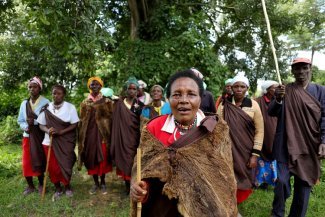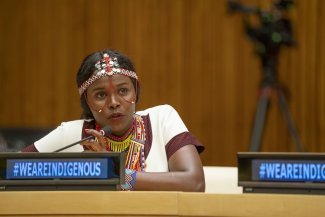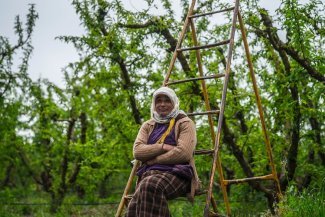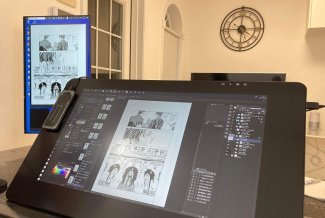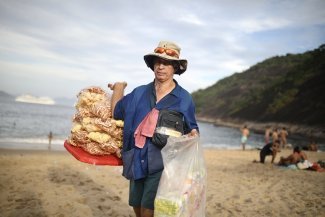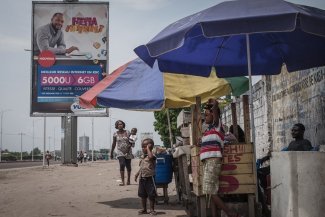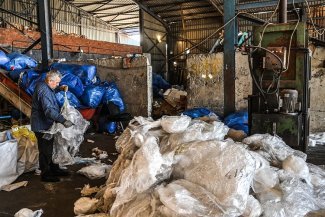A flock of sheep near the town of Ifrane, in the Middle Atlas region of Morocco.
“We are like the dead here, we have grass growing on our grave,” says Chouaïb Rhhou, a man in his fifties, pointing to the grass growing on the roof of his house. Having been evicted in 2019, he now lives on the slope of a hill overlooking the very chic town of Ifrane, in the Moroccan Middle Atlas, with his two adult sons, his wife, two of his grandchildren and the family’s 500 sheep. The place looks like a vast desert steppe. Makeshift structures, made of stone, wood, plastic sheeting and reed, house a kitchen in one spot, a large living room in another, a bedroom further on and two very large sheep pens.
“I was living in Aït Moussa, a douar [village], near El Hajeb, in the plain, at the time when, in the 1960s, the Royal Armed Forces (FAR) took several thousand hectares of land from my tribe, the Aït Naamane, to set up a training centre, without giving us any compensation. For many years, we and our herds were tolerated. But in 2019, 31 families received an eviction notice. I fell back on our summer pasture, here near Ifrane, which also belongs to the tribe, but it’s not suitable during the winter season,” says Rhhou. Near the sheep pen, he points to some logs and bags of grain. At 1,400 dirhams (approximately US$135) a tonne, he has just enough to last a month when the snow blocks the sheep in the sheepfolds.
“On top of that, our nouabs [tribal representatives] are pushing me to leave so that they can lease the land to other investors,” says the sheep farmer.
The grabbing of tribal lands that covered almost the whole of present-day Morocco at the beginning of our era dates back to the introduction of Islam to Morocco, around the 8th century. In Islam, land belongs to God alone and, on Earth, this eminent right is exercised by his representative, the Sultan. The application of this principle above all amounted to the imposition on the Amazigh (also known as the Berber) tribes of a tax, the kharaj, payable only by non-Muslims.
At the beginning of the 20th century, the French Protectorate took up this distinction and placed all the tribal territories – ‘collective lands’, in colonial terminology – under the control and protection of the state. This ‘trusteeship’ was to enable the new administration to keep a firm grip on land distribution, to control the appetite of French settlers. It was enshrined in law and was maintained after independence: collective lands were deemed non-transferable and inalienable, unless in favour of a public body.
Today, tribal lands are estimated at 15 million hectares, a little less than a quarter of Morocco, over which 4,563 tribes are spread. According to various census sources, the number of ‘rights holders’ (tribe members entitled to a share in the sales) is somewhere between 304,000 and 2.5 million, out of an estimated total of nearly 10 million inhabitants, which is around a quarter of the country’s total population.
According to an article in the Moroccan newspaper La Vie Eco, they include 12.6 million hectares of rangeland (pasture), 2 million hectares of agricultural land that occupy 18 per cent of the utilised and highly coveted agricultural land area, and 350,000 hectares located in urban and peri-urban areas valued at an estimated 180 billion dirhams.
Over the years, urban growth and the promotion of intensive and export-oriented agriculture in rural areas have put increasing pressure on tribal lands.
“The lands of the Hadadda were the first collective lands connected to the city of Kenitra [north of the capital, Rabat], so everything went very quickly. There have been several expropriations since 1935. In 2004, another 104 hectares were sold,” says Rkia Bellot, a naïba (representative) of her tribe. In the 2000s, these large-scale sales gave rise to the Soulaliyate women’s movement that began calling for their share of the money distributed from the land sales, from which they were excluded by the custom giving precedence to men.
In rural areas, agricultural policy is also putting pressure on tribal lands. “Using communal agricultural land [sulaliyat] for investment projects in farming should serve as a powerful lever for improved economic and social conditions, especially for rights holders,” King Mohammed VI himself declared on 12 October 2018. The 2020-2030 Generation Green Plan presented to the King in 2020 to implement this royal vision provides for the mobilisation of one million hectares of collective land, which amounts to half of their agricultural land.
Land grabbing in the name of development
For the state, this policy of grabbing tribal lands is justified in the name of Morocco’s development. The government considers collective lands to be poorly managed and unproductive by nature.
“On the death of a right holder with no male descendants, his share is recovered by the community and reallocated to new right holders. This discontinuity [...] poses the problem of repaying loans [if any] granted to the deceased,” explains Bensouda Korachi Taleb, director of Land Development at the Ministry of Agriculture in 1998 in his article Towards land privatization: the role of the State in the modernisation of land tenure systems in Morocco, published by the United Nations’ Food and Argiculture Organization (FAO).
To facilitate this privatisation drive, three new laws were passed in 2019. “For years, the state had difficulty taking over these lands, because it always had to put forward an argument that it was in the public interest, then transfer ownership of the plot to the state before subsequently selling it to a private person by changing its mind about its purpose,” explains Amina Amharech, a French teacher, poet and rights defender for the Amazighs, an ethno-linguistic minority in Morocco and several other countries in the region. “Now, they can be sold or leased to anyone, public or private, by mutual agreement.”
Hajib Kerkibou, an Arabic teacher in El Hajeb, a member of the Aït Naamane and an Amazigh activist, notes that, as a result, “the caïd is constantly pressuring the Aït Naamane to find out if they have any land available, but for the moment our nouabs are saying no”. In theory, land cannot be transferred without the consent of the nouabs, the representatives of the tribal peoples. If they manage to remain united and choose to oppose the sales, the state cannot, in principle, do anything. But the caïd, the local representative of the Ministry of the Interior, who has legal trusteeship over collective lands, intervenes directly in the appointment of the nouabs.
In Sidi Bouknadel, north of Kenitra, near the capital, Rabat, the Ouled Sbita tribe used to have a beautiful beach: the Plage des Nations. “Beyond the beach, between the wadi [a low, dry valley] and the road, we never agreed to sell our land, so ‘they’ took some people who were not even Ouled Sbita and these people declared on behalf of the tribe that we agreed to the sale. We had appointed a genuine internal representative but, because he refused the sale, he was sidelined,” said Saïda Sekkat in 2007. Elected by the commune, this young woman was leading the tribe’s fight at the time against Addoha, Morocco’s leading property developer, which was building a 500-hectare luxury property complex on their land.
The trusteeship of collective lands gives the false impression that the state and the tribes have the same interests but, in reality, it prevents the tribes from being able to defend themselves. Chouaïb Rhhou, together with other members of his tribe, had come up with a small real estate project, a very profitable activity in Morocco, on the lands of the Aït Naamane, near Ifrane, but the approval required from the caïd never materialised.
“If the caïd really wants to sell a piece of land, he only has to gather the signatures from three of the 17 nouabs that our tribe has, while to develop a project between right holders, on our own land, we have to gather the signatures of all the 17 nouabs, as well as having to redistribute the money from sales made by the tribe,” says Kerkibou.
To further accelerate the privatisation of tribal lands, the state is also supporting the melkisation of collective lands. This involves dividing collective lands into plots and distributing them by name, in the form of private property (melk), to the right holders: adults of age and tribe members who live on the land concerned. Two pilot projects are underway with 51,000 and 16,000 hectares of land in the irrigation perimeters of the Gharb and Haouz.
Unlike the sell-offs, “tribal members are very happy with it, much more so than with undivided ownership,” says Amhrech. “Mass melkisation is more pernicious than land sales or rentals. When you tell someone they have to leave, you risk resistance; melkisation is a way of avoiding this confrontation. The state gives everyone a small piece of land and everyone only thinks of one thing: selling it. And because all the right holders do it at the same time, the price collapses. We no longer think in terms of a collective. Each family leaves with 50,000 or 100,000 dirhams to go and live in the city, but it’s not enough and the money only lasts for a while.” Like the others, the Aït Naamane, near El Hajeb, would like to see this form of privatisation. “We applied for the melkisation of our urban land in 2018, but we’ve had no response. The land is going, no matter what we do, so we might as well have it for ourselves,” says Mouloud Kassimi, a naïb.
“The state, as it sees it, is pursuing the national interest by promoting ‘economic take-off’, but it has never encouraged the tribes to develop their land. For as long as there is no concern about the country taking off with its people, we will never succeed. There is indeed a development plan in Morocco, but it is being carried out at the expense of the majority and the grassroots,” decries Amharech.




